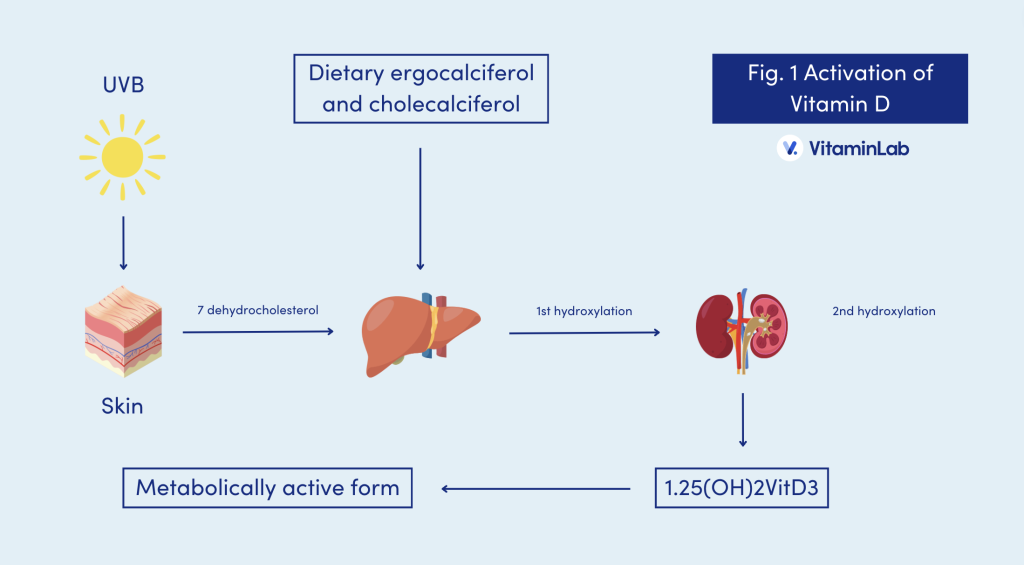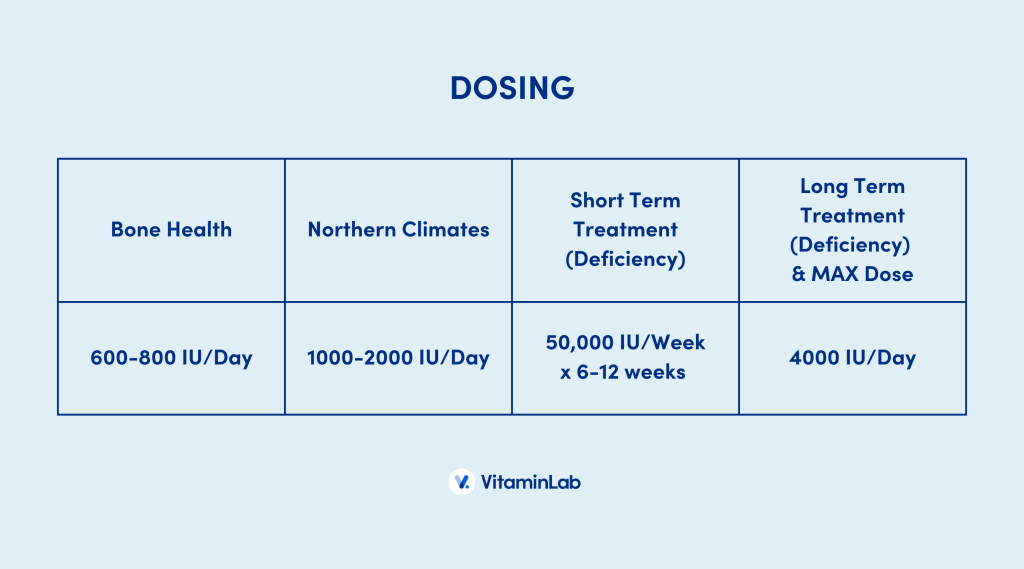Vitamin D deficiency is becoming increasingly more common in America and can have both short and long term detrimental effects on your health. Very few foods contain therapeutic levels of Vitamin D. This means if you have a deficiency of Vitamin D, you may not be able to achieve adequate levels through diet alone.
As many of us work indoors, without direct sun exposure, the detection of Vitamin D deficiency and supplementing Vitamin D is very important. Despite this nutrient being called a vitamin, it is actually steroid hormone that connects our physical bodies to a star: our sun.
Where Does Vitamin D Come From?
In humans, most circulating vitamin D is synthesized from cholesterol following exposure to ultraviolet B (UVB) in sunlight, whereas a smaller amount is derived from diet and dietary supplements.

Diet contributes only between 10% and 20% to Vitamin D levels but becomes more important when sunshine exposure is low. Fish is the major dietary source of vitamin D in humans, plus eggs, fortified dairy products, cod liver oil, and certain types of mushrooms. Calcitriol, or 1,25-dihydroxy vitamin D, is the hormonally active form of vitamin D that is derived from the following three sources: sunlight, diet, and dietary supplements. There are two precursors to active vitamin D hormones, vitamins D3 (cholecalciferol) and D2 (ergocalciferol). Vitamin D3 is synthesized in the skin after exposure to UVB light. It may also be obtained from some dietary sources and dietary supplements. Vitamin D2 is derived solely from the diet (and not from UVB).
How Common Is Vitamin D Deficiency?
It is estimated that over 1 billion people worldwide have low vitamin D levels. Yes, 1 billion. The worldwide high prevalence of vitamin D deficiency is often presented as being clearly linked with the high burden of Vitamin D deficiency complications. Vitamin D deficiency is broken down to Vitamin D insufficiency and Vitamin D deficiency concluded through laboratory analysis. The numbers for Vitamin deficiency are staggering. Here are some notable statistics from the Institute of Medicine (IOM)- the nation’s think tank for health research:
- Complications due to sub-optimal Vitamin D levels run at 50-70% of children, an average of 50% of adults, and over 90% of US senior citizens.
- Prevalences of vitamin D deficiency are 15.1% and vitamin D insufficiency 43.8%.
- The number of diagnoses for vitamin D deficiency drastically increased from 2007 to 2010: an estimated 7.5 million outpatient visits were linked with a diagnosis of vitamin D deficiency in the US alone.
- It has been found that a rise in the serum Vitamin D levels of all Europeans to 40 nmol/L (achieved by a daily intake of 2000–3000 IU of vitamin D) would lower health-care costs by up to 17%,– a reduction of 187,000 million US/year.
How Vitamin D3 and Vitamin K2 Work Together
Research suggests that these two vitamins work synergistically to regulate calcium metabolism in the body, thereby promoting optimal bone density and reducing the risk of fractures. Vitamin D3 facilitates the absorption of calcium from the intestines, while vitamin K2 directs the deposited calcium towards the bones and teeth instead of soft tissues like arteries. Studies, such as a randomized controlled trial published in the American Journal of Clinical Nutrition, have demonstrated the efficacy of vitamin D3 and K2 supplementation in improving bone mineral density (BMD) and reducing the incidence of arterial calcification. Additionally, this combination is believed to play a crucial role in cardiovascular health by preventing the accumulation of arterial plaques. A meta-analysis published in the Journal of Lipid Research highlights the potential of vitamin K2 in reducing arterial stiffness and lowering the risk of cardiovascular events.
Read more about the health benefits of Vitamin K2.
10 Signs and Symptoms of Vitamin D Deficiency
1. Depression
Vitamin D plays a role in regulating adrenaline, noradrenaline, and dopamine production in the brain, as well as protecting against the depletion of serotonin and dopamine. This is the possible link with vitamin D’s role in depression. The research is new in this area, and only the associations have been shown so far. Vitamin D deficiency has been associated with an 8%-14% increase in depression.
2. Joint and Muscle Pain
Many of the health benefits associated with vitamin D may come from its role in decreasing inflammation. Research has shown a decrease in levels of C-reactive protein, a marker of inflammation. The relationship between Vitamin D and bone health is well known, but it can also impact joint and muscle health. Any part of the body can be affected but common areas include hips, wrists and hands, chest and breastbone, and the long muscles of the legs and back.
3. Gastrointestinal Issues
Studies have clearly shown that people with Irritable Bowel Syndrome are consistently low in Vitamin D levels. This means constipation, diarrhea, gas & bloating, abdominal tenderness. Also, people with bowel problems like Crohn’s, gluten sensitivity, or other malabsorption problems can have a difficult time absorbing Vitamin D.
4. Hyperhidrosis or excessive sweating
Excessive sweating due to neuromuscular irritability and overstimulation of sweat glands is still described as a common, early symptom of vitamin D deficiency. The most common areas for this to occur is the head and neck.
5. Hormone Imbalances
Since Vitamin D really acts more like a hormone than a vitamin in most bodily functions, Vitamin D can have a tremendous impact on the rest of the hormones in your body. Here are just some examples of how Vitamin D affects your hormones:
- Vit D decreases expression estrogen in Breast Cancer cells
- Progesterone & Vitamin D have synergistic effects for neuroprotection
- Vitamin D administration increases total, free, and bio-available testosterone in men.
Furthermore, since Vitamin D deficiency is also related to Cardiovascular disease and Cardiovascular disease is related to Erectile Dysfunction (ED), some researchers have suggested that Vitamin D may be helpful for ED.
6. More Colds or Breathing Difficulties
Individuals with Vitamin D deficiency are at higher risk for upper respiratory infections and wheezing disorders. Vitamin D has also been implicated in the reversal of corticosteroid resistance and in airway remodeling, which are the hallmarks of chronic obstructive pulmonary disease and severe asthma.
7. Trouble Sleeping?
Vitamin D deficiency has been correlated in people who suffer from sleep apnea. It has also been shown to be more common in children who suffer from nightmares.
8. Eczema, Psoriasis and Skin Disorders
Allergic and autoimmune conditions of the skin such as psoriasis, eczema, and hives have all responded favorably to Vitamin D supplementation.
9. Being Overweight or Obese
Overweight and obese people produce less active Vitamin D than individuals with normal BMI. Prevalence of Vitamin D deficiency is higher in persons with high subcutaneous adiposity and high visceral adiposity than in persons with low subcutaneous and visceral adiposity.
10. For Those with Dark Skin…
African Americans are at greater risk of vitamin D deficiency, because if you have dark skin, you may need as much as 10 times more sun exposure to produce the same amount of vitamin D as a person with pale skin.
Optimizing Vitamin D Levels Can Help Prevent Chronic Diseases
Vitamin D supplementation has been found in research to have positive effects on the following health conditions:
- Psoriasis
- Rickets
- Osteoporosis
- Cardiovascular diseases such as hypertension, heart attack, and stroke.
- Muscle Weakness
- Depression
- etc.
What Are The Optimal Levels of Vitamin D?

At present, based on the evaluation of healthy populations that get plenty of natural sun exposure, the optimal range for general health appears to be somewhere between 50 and 75 ng/ml.
As for how to optimize your vitamin D levels, we firmly believe that appropriate sun exposure is the best way. 15-20 min of direct sunlight to 20% of your body is all you need to achieve an optimal range. Treatment of vitamin D deficiency in healthy individuals or those with serious illness (cancer, cardiovascular disease, multiple sclerosis, diabetes, autism) should be individualized to maintain 25-hydroxyvitamin D levels in the normal range (50-75ng/mL).
What Is The Best Dosing For Vitamin D Deficiency?

Up until recently, research suggested taking 1000 IU (25mcg) daily to reach an optimal vitamin D status of 70nmol/L, however, new research suggests an intake for all adults of 2,000 IU (50mcg) daily to achieve a new optimal vitamin D status of 75nmol/L. For short-term treatment of Vitamin D deficiency, doses of 50,000 IU per week for 6-12 weeks are often needed (cumulative dose of 600,000 IU or more). For long-term treatment, maximum doses should not exceed more than 4000 IU/day for adults. Maximum doses are at 4000 IU/day to avoid hypercalcemia and toxicity occurs at 10,000 IU/day. The new recommended daily allowance (RDA) for bone health, is as follows: <70 years of age, 600 IU daily; > 71 years, 800 IU daily; and for pregnant and lactating women, 600 IU daily.
It is strongly recommended to add Vitamin D to your supplementation regimen to ensure you’re avoiding any Vitamin D deficiencies. Add Vitamin D to your formula.

Resources
1. Natural Medicines Database. Vitamin D Professional Monograph.
2. Textbook Of Natural Medicine. Pizzorno, Joseph E., Murray, Michael T. 4th Ed. St. Louis, Mo: Churchill Livingstone. 2013
3. Role Of Vitamin D Deficiency In Extraskeletal Complications: Predictor Of Health Outcome Or Marker Of Health Status? Guessous, I. BioMed Research International. Volume 2015 (2015)
4. Zhuang, Y., Zhu, Z., Chi, P., Zhou, H., Peng, Z., Cheng, H., Xin, X., Luo, W., Si, S., Mo, M., Chen, D., Liu, H., & Yu, Y. (2023, August 24). Efficacy of intermittent versus daily vitamin D supplementation on improving circulating 25(OH)d concentration: A bayesian network meta-analysis of randomized controlled trials. Frontiers in nutrition. https://www.ncbi.nlm.nih.gov/pmc/articles/PMC10488712/
5. Kuang , X., Liu, C., Guo, X., Li, K., Deng, Q., & Li, D. (2020, April 30). The combination effect of vitamin K and vitamin D on human bone quality: A meta-analysis of randomized controlled trials. Food & function. https://pubmed.ncbi.nlm.nih.gov/32219282/







1 comment
Good day our cherished one! I want to claim that pros and cons remarkable, excellent written and will include somewhere around almost all sizeable infos.. vitamin d symptoms I have to notice far more posts similar to this .